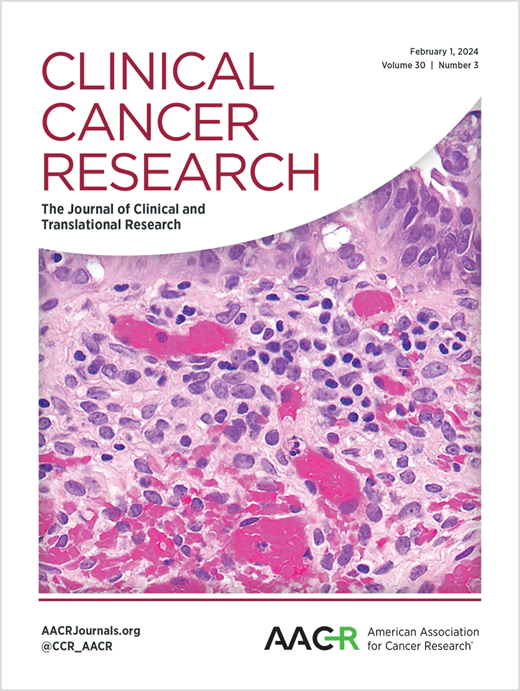A Prospective Study Consortium for the Discovery and Validation of Early Detection Markers for Ovarian Cancer ("PREDICT") - Baseline findings for CA125.
IF 10
1区 医学
Q1 ONCOLOGY
引用次数: 0
Abstract
PURPOSE Epithelial ovarian cancer (EOC) is a lethal malignancy. CA125, the "best" available marker for detecting EOC, has insufficient sensitivity and specificity for earlier-stage disease and is not a meaningful screening tool, motivating the search for further biomarkers. Cancer biomarker discovery is enhanced by "omics" technologies. Discovery studies for EOC biomarkers should be conducted in pre-diagnosis blood samples from prospective cohorts to maximize likelihood of identifying markers that can detect disease before usual diagnosis and in earlier disease stage, while reducing methodologic biases. EXPERIMENTAL DESIGN Individual cohorts with pre-diagnosis blood samples have insufficient sample size for such studies. thus, we established "PREDICT" ("Prospective Early Detection Consortium for Ovarian Cancer")-a collaboration of nine prospective studies-to assemble a sufficient number of EOC cases with blood samples collected ≤18 months before diagnosis plus controls. The 457 cases and 1,687 controls have circulating CA125 measured using a clinical assay. RESULTS The discrimination capacity for single CA125 measurements in samples collected <6 months prior to diagnosis was high (area under the curve (AUC), PREDICT overall=0.92; range across cohorts of non-pregnant individuals=0.89-0.98), and declined with extended time between blood collection and diagnosis. Between-cohort variability in CA125 levels and predictive performance was observed. CONCLUSIONS Ongoing investigations in PREDICT are evaluating the early detection potential of tumor-associated autoantibodies and microRNAs, using CA125 as a benchmark. PREDICT is a well-characterized resource for identifying and validating detection markers for EOC that may then be used in multi-modal screening, as a complement to CA125 and combined with imaging.发现和验证卵巢癌早期检测标志物(“PREDICT”)的前瞻性研究联盟- CA125的基线结果。
目的上皮性卵巢癌(EOC)是一种致死性恶性肿瘤。CA125是检测EOC的“最佳”可用标志物,但对早期疾病的敏感性和特异性不足,不是一种有意义的筛查工具,这促使人们寻找进一步的生物标志物。“组学”技术加强了癌症生物标志物的发现。EOC生物标志物的发现研究应在前瞻性队列的诊断前血液样本中进行,以最大限度地确定在常规诊断之前和早期疾病阶段可以发现疾病的标志物,同时减少方法学偏差。具有诊断前血液样本的个体队列不足以进行此类研究。因此,我们建立了“PREDICT”(“卵巢癌前瞻性早期检测联盟”)——一个由9个前瞻性研究组成的合作项目——以收集足够数量的EOC病例,并在诊断前≤18个月采集血样并进行对照。457例患者和1687例对照患者使用临床测定法测定循环CA125。结果在诊断前6个月采集的样本中,单次CA125检测的鉴别能力较高(曲线下面积(AUC)), PREDICT总体=0.92;非怀孕个体的队列范围=0.89-0.98),并且随着采血和诊断之间时间的延长而下降。观察CA125水平和预测性能的队列间变异性。结论PREDICT正在进行的研究正在评估肿瘤相关自身抗体和microrna的早期检测潜力,以CA125为基准。PREDICT是一种特性良好的资源,用于识别和验证EOC的检测标记,然后可用于多模式筛查,作为CA125的补充,并与成像相结合。
本文章由计算机程序翻译,如有差异,请以英文原文为准。
求助全文
约1分钟内获得全文
求助全文
来源期刊

Clinical Cancer Research
医学-肿瘤学
CiteScore
20.10
自引率
1.70%
发文量
1207
审稿时长
2.1 months
期刊介绍:
Clinical Cancer Research is a journal focusing on groundbreaking research in cancer, specifically in the areas where the laboratory and the clinic intersect. Our primary interest lies in clinical trials that investigate novel treatments, accompanied by research on pharmacology, molecular alterations, and biomarkers that can predict response or resistance to these treatments. Furthermore, we prioritize laboratory and animal studies that explore new drugs and targeted agents with the potential to advance to clinical trials. We also encourage research on targetable mechanisms of cancer development, progression, and metastasis.
 求助内容:
求助内容: 应助结果提醒方式:
应助结果提醒方式:


